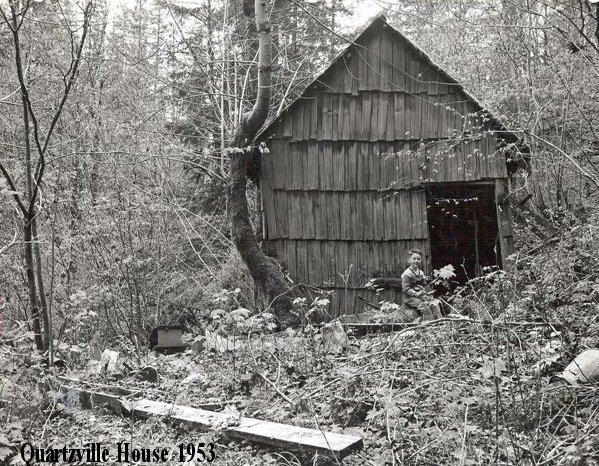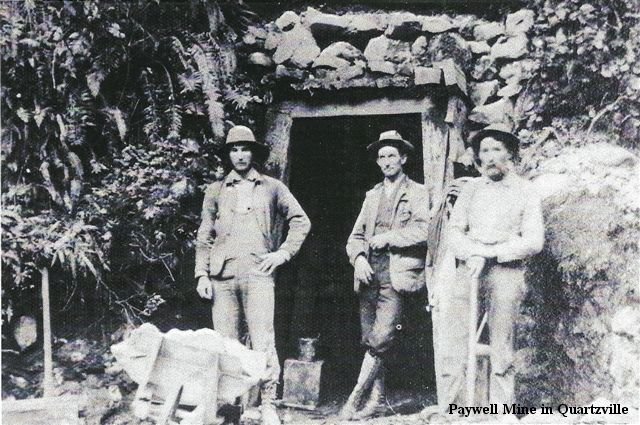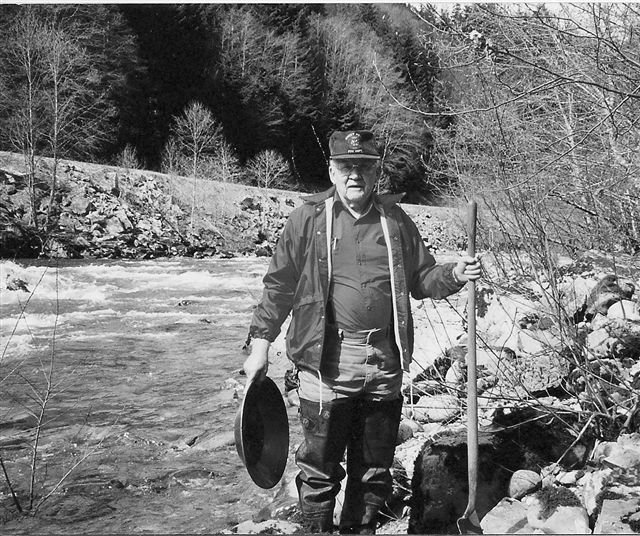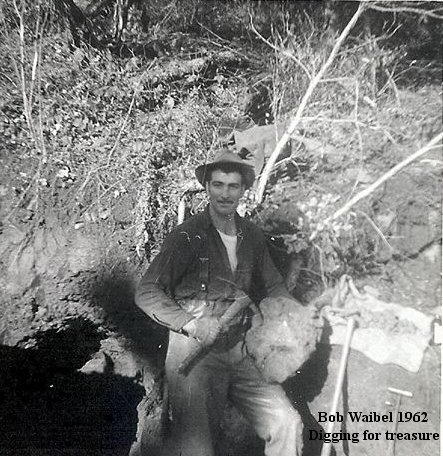QUARTZVILLE GOLD
by
Mona Hyer Waibel
![]()
Buckhead (early Sweet Home) citizens were watching and at first were applauding. Sweet Home’s connection to gold has always
been close.
Gold
was discovered in this area in 1848, but it took 16 years for the prospectors to
arrive. Jeremiah
Driggs filed the first gold claim on
Sept.
5, 1863. By 1869, 500 claims had been filed and a
stamp mill and saw mill built. A
very rough, unimproved road led to the mines, and the men of
Linn
County
were eager to pack their gear into these operating mines and get
rich.
 Quartzville,
on the Santiam
River,
was a flash during the booming time of gold rush in this area. The town of 1,000, in the rugged mountains 30
long miles from Sweet Home and Foster, appeared out of nowhere. Logs lay on the
stump-lined streets, where no one had bothered to move them, in the way of
wagons and people arriving.
Quartzville,
on the Santiam
River,
was a flash during the booming time of gold rush in this area. The town of 1,000, in the rugged mountains 30
long miles from Sweet Home and Foster, appeared out of nowhere. Logs lay on the
stump-lined streets, where no one had bothered to move them, in the way of
wagons and people arriving.
Quartzville
stamp mill extracted the gold from the quartz rock. Gold
was the attraction all right. When the gold was gone, the town
died.
The
first wagon road started at Gates, between the
North
Santiam
River
and Quartzville Creek. It was a steep, rough road that allowed wagons to bring
materials and supplies in for the miners’ needs.
The
wild town of Bryant City,
which flourished for a short time during the rush, included a “red light”
district. Bryant City was abandoned by 1870.
Two
good placer mines working were the Jackass and Donaca
Bar mines located on the lower drainage of Quartzville Creek. Other lesser mines
also were operating until 1900, including the Lone Star and
White Bull Mountain.
Two other productive lode mines were the
Albany and Lawler.
Despite
its early success, it became apparent that the gold strike was not a rich one
that would sustain many miners. The Santiam gold and silver mines were
disappointing to all the Oregonians who had placed their faith in vast riches.
The
Red Bull Mine was still sending men into its tunnels hoping for a new
strike. More excitement came in the
early 1900’s with new machinery coming to the Red Bull and White Bull mines
searching again for that big rush of gold.
The U.S. Mint reports the largest output of gold in 1896 was 3,938.92
ounces from the Quartzville mines.
Lewis
A. McArthur reports in his “Oregon Geographical Names” that Quartzville,
Linn County,
was once an important locality due to gold discoveries in the early 1860’s. The
place was laid out as a town in 1864 and a stamp mill built in that year. The
Oregonian, optimistic about the “Santiam Mines” in the first few years of the
1860’s and into 1869 turned sarcastic and called it “THE END OF A GREAT MINING
SPECULATION.”
The
paper reported: “A few years ago all
Oregon was agog with the excitement over the supposed untold riches of the Santiam Gold
and Silver Mines.
“Dozens,
nay almost hundreds, of joint stock companies were organized. Millions of joint stock was issued, wasting
heaps of bank note paper and hundreds of hands into hundreds of pockets and
pulled out hundreds and thousands of dollars – thousands, which they were
destined never to see again, in this life. Mining schemes went up like rockets
and came down like burnt sticks, and people with burnt fingers were thicker even
than the burnt stocks.
“A
host of expectations were created by Santiam discoveries; tens of thousands of
dollars were expended in constructing a road, opening mines, building dwellings
and in erecting a saw mill and quartz mill.
The work was well done and proved expensive because great results were
hoped for and no pains were spared to provide the needed means and appliances.
“Santiam
stock is no better than waste paper; the buildings are literally the habitations
only of bats and owls and the dreary tunnels are hideous bores. They bored heavily into the gold on hand
instead of pouring out the anticipated dividends, and will probably stand for
centuries to come, a reminder of the past enterprises and failures. The saw mill
has been transported elsewhere with more success. Yes, this was the end of the
gold strike in Quartzville.”
Much
later, three brothers from the Aho family of
Gresham came to the Quartzville mines, for many years toiling in the mountains and
mines, lured by the same glittering metal that made this area a booming mining
town. These brothers, Edward, Wayne and John were partners in mining ventures
since the 1930’s. They had some good assays from ore samples taken from their
claims. They filed three claims: the Santiam Lily in 1933; the Silver Ridge in
1935 and finally the Relief mine.
Three
tunnels were located in the same general area. The Aho’s brought in a generator, a wheel barrow, mining
equipment and dynamite. The assay reports didn’t mean these claims would be
profitable, and Gus Hiller of the Western Mining Council and a friend
agreed. Hiller hiked into the mines many
times with the brothers, and warned them of the dangers of mining and using
dynamite.
The
brothers stayed in a cabin every summer and worked their mines as years went
by. Inside the tunnel, a carbide lamp
lit the way. In June 1976, the brothers lit a charge of dynamite with the lamp,
the fuse was short and the three men died together in an explosion while they
were exploring for the gold ore that brought them back summer after summer.
A sad ending of a quest for
gold.
 Gold
has also been recovered from placer deposits.
Gravel bars along the Quartzville Creek drainage and parts of the Middle
Fork of the Santiam River were placered in the middle 1800’s and again in the 1930’s. During the Great Depression, miners using
hand-placering mining equipment were able to recover enough gold to survive.
During 1935, 11 mines were worked on three creeks in
Linn County.
That year small-scale gold miners in Oregon sold gold with a total weight of 4,021 ounces and a value of $140,730 to bullion
buyers. Miners made an average of $1.19
a day. Five thousand
ounces of silver was mined thru the years until 1980s, with 15,000 ounces of
gold.
Gold
has also been recovered from placer deposits.
Gravel bars along the Quartzville Creek drainage and parts of the Middle
Fork of the Santiam River were placered in the middle 1800’s and again in the 1930’s. During the Great Depression, miners using
hand-placering mining equipment were able to recover enough gold to survive.
During 1935, 11 mines were worked on three creeks in
Linn County.
That year small-scale gold miners in Oregon sold gold with a total weight of 4,021 ounces and a value of $140,730 to bullion
buyers. Miners made an average of $1.19
a day. Five thousand
ounces of silver was mined thru the years until 1980s, with 15,000 ounces of
gold.
When
I was a child, our families camped along the
Santiam River,
using gold pans to see what we could find. This was a mini-vacation and as close
to a vacation as we had during the Depression years. The bonfires, the meals we cooked over the
fire pit, sleeping out of doors and the mosquitoes were mostly good memories in
the 1930’s.
My
dad, Floyd Bryant, always salted my pan to make it more exciting when I squealed
because there was a nugget there. The many local unemployed found that, with a
little luck, they could spend several days at Quartzville panning and make
enough to buy groceries for the week. Sometimes we did too.
My
mom, Audrey Bryant, worked hard to make tasty meals cooked in iron skillets and
large heavy metal pans during our stay. My brothers and I had beans and weenies
a lot of the time. The toast we made was always covered with no-see-ums that
stuck to the honey. But we ate them anyway.
These
were great memories and we always felt the excitement of the early miners who
found their fortune along this river too. The ghosts of these long-ago
prospectors seemed to be hanging around for a good look at what we were doing
there. But we never were afraid, just felt comfort in knowing these men had
success doing long ago what we attempted too.
 Bob
Brandt enjoyed gold panning and climbing in and out of the old Quartzville mine
shafts. He had gold fever, and his search for the yellow mineral was a strictly
recreational prospect. Studying
geology and the lay of the land gave Brandt an insight into how the veins of
gold were lying along the river and also sheltered up on the shelves of the
hills around the gold mining area. He filed a few claims in his day. His first,
in 1947, produced gold that was in a flat, flaky form. He could pan all day for
$1 to $1.50 worth of gold. The federal government controlled the price and in
the late 1940s it was $35 an ounce.
Bob
Brandt enjoyed gold panning and climbing in and out of the old Quartzville mine
shafts. He had gold fever, and his search for the yellow mineral was a strictly
recreational prospect. Studying
geology and the lay of the land gave Brandt an insight into how the veins of
gold were lying along the river and also sheltered up on the shelves of the
hills around the gold mining area. He filed a few claims in his day. His first,
in 1947, produced gold that was in a flat, flaky form. He could pan all day for
$1 to $1.50 worth of gold. The federal government controlled the price and in
the late 1940s it was $35 an ounce.
Through
years of enjoying the times spent running a small dredge, he accumulated many
good specimens. Brandt had a fine
collection of gold dust, nuggets and made some of it into bars of pure gold. In
later years he donned a wet suit and used a suction dredge to search in crevices
and beneath boulders. In
1976, Brandt’s skill at whirling and shifting the contents of a gold pan,
separating heavy gold from sand, earned him the title “state champion gold
panner” at the Lane
County
fairgrounds.
His largest bonanza was
a 2 1/2 ounce chunk of gold from a Merced,
Calif. mining trip in the
1950’s. The largest single nugget ever
recorded was found in Australia. The Hand of Fate
nugget weighs 58 lbs. and valued at over $1 million.
In
the 50 years Brandt pursued the gold, he spent most of his weekends with his
wife Sylvia and their two children, Jack and Ellen, with a picnic lunch and a
hunger for touches of gold. He
worked the rest of the week delivering mail for the Sweet Home Post Office,
mostly via his bicycle. This outgoing man was well known in the community,
serving on the school board, Boy Scout leader, volunteer fire department and
also the City Council.
He was known in recent years as a regular at Mollie’s Bakery during coffee time
with friends who gathered each morning playing a guessing game and seeing who
paid for the group’s bill. Bob
Brandt passed away in 1997 and his gold is also gone, but his many friends miss
his humor and presence.
My family was privileged
to share this pastime often; it was either panning gold or digging for rocks all
over this county. Our
two families accumulated Holley Blue agate,
Chandler
Mountain
carnelian, jasper, thunder eggs, geodes from around Foster reservoir and so many
more kinds of choice rocks too. The
Brandt’s were our special adventuring friends. Panning no longer gives a man a
day’s wages, but the thrill is still there. Yes, we were some of the ones that
packed a picnic lunch to eat along the banks of the
Santiam
River
and enjoy all the things that nature bestowed. We were all Sweet Home Rock Club
members.
 Active
prospectors continue to dredge gold from Quartzville Creek. The precious metal
has not lost its charm or interest. And in 2007, some old-timers like to play
the role of prospectors, though younger people wear wetsuits that are better for
the cold water of the Santiam
River.
Active
prospectors continue to dredge gold from Quartzville Creek. The precious metal
has not lost its charm or interest. And in 2007, some old-timers like to play
the role of prospectors, though younger people wear wetsuits that are better for
the cold water of the Santiam
River.
A
few prized one-ounce nuggets have been found recently, which encourages people
to keep looking. Today’s miners may use
a White’s Electronics gold metal detector especially made for searching for
gold. These are manufactured in our
town.
Visit
Oregon
Prospecting & Rita’s Relics at 1045
Main St.,
where Rita sells gold pans and everything you need, and will show you how to use
one. Rita also takes would-be miners to Quartzville.
Although commercial mining is over, small amounts of gold are still found in the
Quartzville area; one crystallized gold specimen appeared as a small piece of
lace. But seemingly no glory holes with
gold nuggets are around today. Remains
of the mine shafts are difficult to find, still hidden behind brush and
dangerously near main roads. Beware! A
sign is now erected on the site of the Bryant City-Quartzville gold rush area.
Otherwise, all traces are gone of Bryant
City
and the buildings that once made up the community.
Oregon will never come close to matching the excitement of our neighbor to the south,
California’s
production of precious metals.
Quartzville
is a nice warm-weather drive, but really not much to see and explore. But our
memories of the ’49ers gold seekers remain and we listen for the call of another
gold strike. And
according the Bob Brandt, “modern-day panners may find gold yet; the gold moves
and the river rebuilds itself.”
There’s
Gold in Them Thar Hills.
![]()
My name is Stephenie Flora. Thanks for stopping by. Return to [ Home Page ] All [ Comments and Inquiries ] are welcome.